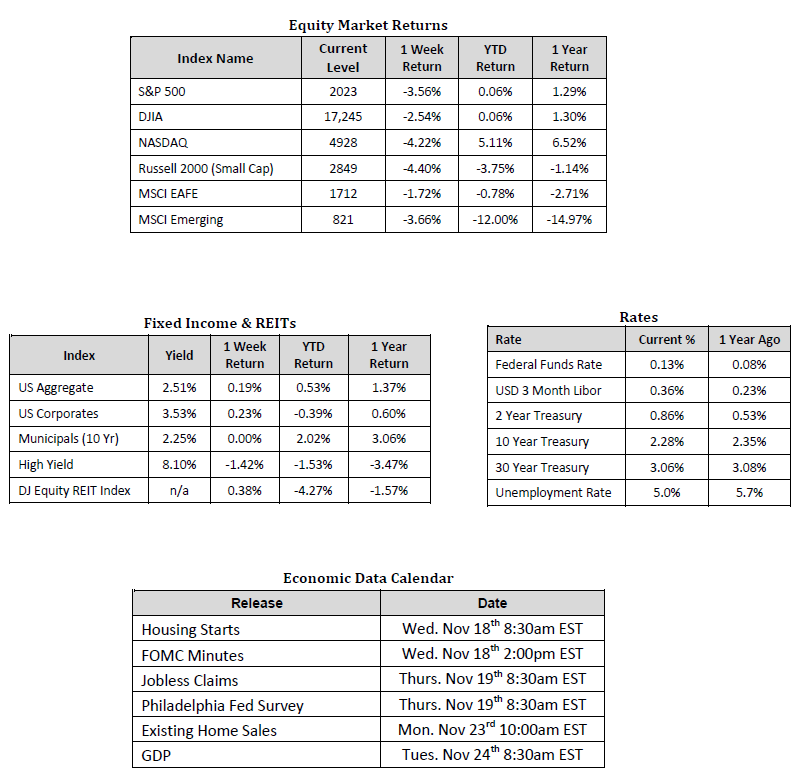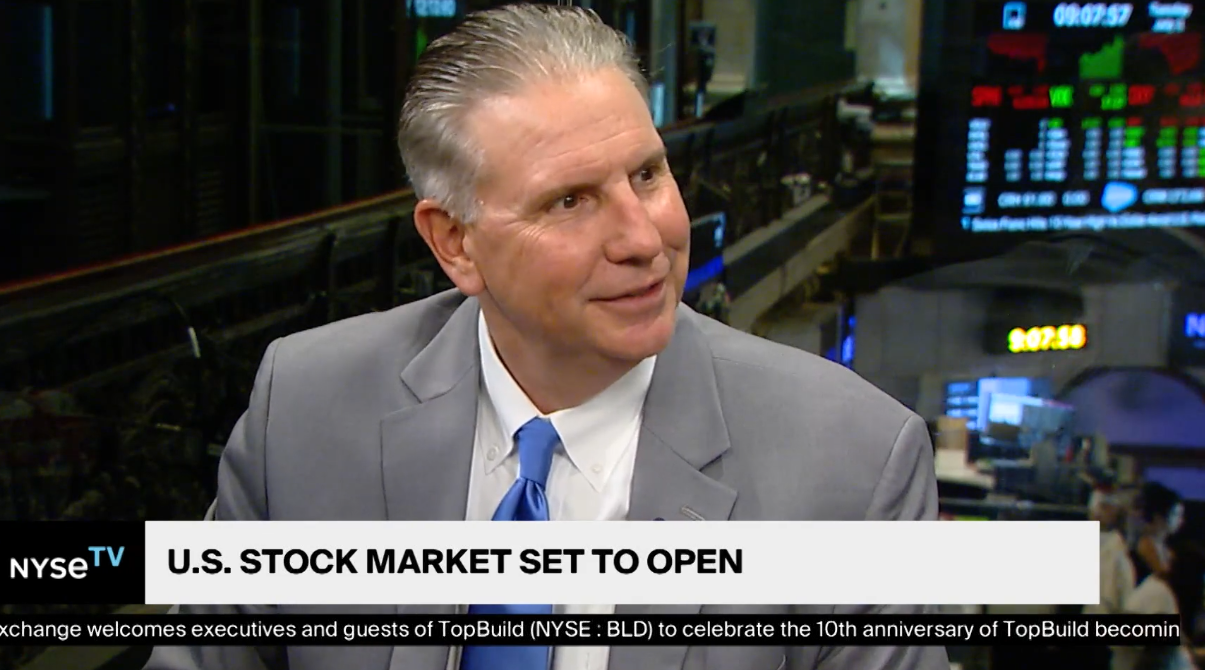
Stocks Slip While Near Term Opportunities Remain
Market Overview

Sources: Equity Market, Fixed Income and REIT returns from JP Morgan as of 11/13/15. Rates and Economic Calendar Data from Bloomberg as of 11/16/15.
Happening Now
U.S. Stocks (as measured by the S&P 500 index) gave back over a third of their Q4-to-date returns last week, falling 3.6% on the back of global growth concerns. These concerns continue to weigh on the minds of market participants as they digest lower commodity prices and softness in Chinese economic data such as industrial output and housing starts, which both fell last week. Domestically, Large-Cap Growth stocks now remain the only style/market-cap combination that are currently up in value this year with a positive 3.9% return while Small-Cap Value stocks are the laggard, down 6.4% year-to-date.
On the international front, Mario Draghi, of the European Central Bank (ECB), suggested last week (in a somewhat controversial way) that inflation readings are below estimates and additional stimulus measures may be necessary to achieve their target for rising prices. Central bank stimulus certainly fueled an expansion in U.S. stock prices and we believe that a similar story is likely to play out in developed European markets, recognizing the some major European markets, such as the United Kingdom, operate under independent bank policy.
It is important to remember, however, that international stocks historically carry more risk than stocks in the U.S. The primary risks in international stocks are typically exposure to foreign currency and export dependency. Investors must remember that when they invest in foreign stocks, through a mutual fund or through an exchange traded fund, their return is going to be combination of the return of the local stock market and the movement in the U.S. Dollar. With regards to exports, should a slowdown in global economic activity play out, Eurozone economies in aggregate are approximately twice as dependent on exports as the United States. For example, according to JP Morgan*, exports account for approximately 18% of the Eurozone’s economy while only accounting for 9% of the U.S. economy. Germany is particularly exposed, seeing close to 37% of their economic growth being fueled by exports.
*According to JPMorgan as of 9/30/2015
Important Information and Disclaimers
Disclosures: Hennion & Walsh is the sponsor of SmartTrust® Unit Investment Trusts (UITs). For more information on SmartTrust® UITs, please visit www.smarttrustuit.com. The overview above is for informational purposes and is not an offer to sell or a solicitation of an offer to buy any SmartTrust® UITs. Investors should consider the Trust’s investment objective, risks, charges and expenses carefully before investing. The prospectus contains this and other information relevant to an investment in the Trust and investors should read the prospectus carefully before they invest.
Investing in foreign securities presents certain risks not associated with domestic investments, such as currency fluctuation, political and economic instability, and different accounting standards. This may result in greater share price volatility. These risks are heightened in emerging markets.
There are special risks associated with an investment in real estate, including credit risk, interest rate fluctuations and the impact of varied economic conditions. Distributions from REIT investments are taxed at the owner’s tax bracket.
The prices of small company and mid cap stocks are generally more volatile than large company stocks. They often involve higher risks because smaller companies may lack the management expertise, financial resources, product diversification and competitive strengths to endure adverse economic conditions.
Investing in commodities is not suitable for all investors. Exposure to the commodities markets may subject an investment to greater share price volatility than an investment in traditional equity or debt securities. Investments in commodities may be affected by changes in overall market movements, commodity index volatility, changes in interest rates or factors affecting a particular industry or commodity.
Products that invest in commodities may employ more complex strategies which may expose investors to additional risks.
Investing in fixed income securities involves certain risks such as market risk if sold prior to maturity and credit risk especially if investing in high yield bonds, which have lower ratings and are subject to greater volatility. All fixed income investments may be worth less than original cost upon redemption or maturity. Bond Prices fluctuate inversely to changes in interest rates. Therefore, a general rise in interest rates can result in the decline of the value of your investment.
Definitions
MSCI- EAFE: The Morgan Stanley Capital International Europe, Australasia and Far East Index, a free float-adjusted market capitalization index that is designed to measure developed-market equity performance, excluding the United States and Canada.
MSCI-Emerging Markets: The Morgan Stanley Capital International Emerging Market Index, is a free float-adjusted market capitalization index that is designed to measure the performance of global emerging markets of about 25 emerging economies.
Russell 3000: The Russell 3000 measures the performance of the 3000 largest US companies based on total market capitalization and represents about 98% of the investible US Equity market.
ML BOFA US Corp Mstr [Merill Lynch US Corporate Master]: The Merrill Lynch Corporate Master Market Index is a statistical composite tracking the performance of the entire US corporate bond market over time.
ML Muni Master [Merill Lynch US Corporate Master]: The Merrill Lynch Municipal Bond Master Index is a broad measure of the municipal fixed income market.
Investors cannot directly purchase any index.
LIBOR, London Interbank Offered Rate, is the rate of interest at which banks offer to lend money to one another in the wholesale money markets in London.
The Dow Jones Industrial Average is an unweighted index of 30 “blue-chip” industrial U.S. stocks.
The S&P Midcap 400 Index is a capitalization-weighted index measuring the performance of the mid-range sector of the U.S. stock market, and represents approximately 7% of the total market value of U.S. equities. Companies in the Index fall between S&P 500 Index and the S&P SmallCap 600 Index in size: between $1-4 billion.
DJ Equity REIT Index represents all publicly traded real estate investment trusts in the Dow Jones U.S. stock universe classified as Equity REITs according to the S&P Dow Jones Indices REIT Industry Classification Hierarchy. These companies are REITSs that primarily own and operate income-producing real estate.



